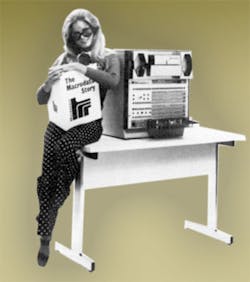From EE’s first issue in April 1962, component reliability was the magazine’s raison d’être. With no microprocessors or DSPs yet developed, the first articles concentrated on passive as well as simple active component reliability and testing. In late 1968, Siliconix advertised the ZIP0 FET Tester that could grade up to 10,000 devices/hour.
By late 1972, Macrodata introduced a logic tester with blazing 10-MHz performance. In mid 1973, Julie Research Labs was using cassette memory in the LOCOST-106 Programmable Test System. Watkins-Johnson sold ADATE automatic digital assembly test equipment that achieved 300k tests/s. And, Lorlin Industries advertised an automated transistor/diode tester.
RAM chips and microprocessors gained a foothold in the 1974-75 period, and several testers became available including one from Biomation. GenRad advertised the Model 2230 Automated Component Tester in March/April 1977, and benchtop IC testers graced the January/February 1978 issue.
EE’s first ATE Buyers Guide ran in March/April 1979 with products from all the major players: Plantronics Zehntel, Fairchild (Xincom), Tektronix, Teradyne, Siemens, Fluke Trendar, Computer Automation, Adar, IE Systems, Autotest, Accutest, Microgamma, Texas Instruments, GenRad, Lorlin, Micro Control, SIR-Atlanta, Everett Charles Technologies, Grumman Aerospace, PDI, and Sage. This mix reflects the interests of test equipment manufacturers, IC companies, and end users for whom reliability was critical.
By the end of the 1970s and start of the 1980s, familiar ATE names were becoming established. LTX maintained a full-page back-cover EE ad for at least a year. Eagle Test wrote an article in January 1981 about digital IC testing. And Hewlett-Packard advertised an incoming inspection IC tester.
GenRad’s 2272 Board Tester appeared late in 1981. Throughout 1982, EE continued bimonthly issues except for the single-month April issue which featured the annual ATE directory.
An article on power cycling as a stress-test method ran in 1983’s April issue along with the annual ATE directory. The May/June issue continued handler coverage and included an article about test-during-burn-in. Power was again featured in the July/August issue in an ATE power conditioning article. EE covered handlers, ATE power conditioning, and ATE standards through 1983 and 1984. A backdriving article ran in January 1984, the year when EE began monthly publishing.
February 1984 saw more coverage of ICT and environmental test screening. The June 1984 issue reached 160 pages and included a story about Soviet ATE. IEEE 488 was discussed in the April 1985 ATE directory issue, and in August, PCs were featured as test controllers.
Handlers again were covered in May 1986, followed in August by manufacturing defect analyzers (MDAs) and in October by mixed-signal ATE. Interestingly, even though the mid 1980s were a period of growth, the concept of lower cost, smaller ATE was discussed in September.
The expansion of personal computing and wireless communications gradually diverted more editorial coverage. Nevertheless, through the 1990s and 2000s, EE attracted a very impressive list of authors who have continued to shape the ATE business in many ways. 1992 featured wafer-probing articles by Mike Bonham and January Kister, followed in September by Bob Stasonis discussing board ATE. Larry Desjardin reviewed VXI progress in 1993, and Malcolm Levy wrote “Device Interfacing for the VXIbus.”
1997 kicked off with a Jerry Broz tutorial on tungsten needle probes followed in 1998 by Andrei Berar’s tribute to system integration and Stephen Sunter’s “Overview of Mixed-Signal DFT.” Dima Smolyansky delved into the “TDR Characterization of ATE Fixture Boards” in 2000; in 2001, Rudy Garcia tackled structural test. And, in 2002, Dr. William Bottoms discussed “Open-Architecture ATE” from his perspective as head of Third Millennium Test Solutions.
Yervant Zorian and Mouli Chandramouli jointly wrote about Virage Logic’s embedded infrastructure IP in 2004. “Exploring the Basics of AC Scan” followed later that year from Al Crouch. Ben Bennetts reviewed boundary scan in 2006, and Jeff Sherry considered the smallest details of load board design in 2010.

